Weekly Reports from Jordan
Choose Year: or Choose week
July 10-16, 2004
Larry G. Herr and Douglas R. Clark
When North Winds Blow
In temperate climates north winds usually bring cold weather, but the opposite was the case this week when a steady north breeze for three days at the tell brought hot weather and blizzards of dust. The normal direction of the wind comes off the Mediterranean to the west and brings relatively cool weather with highs in the mid to upper 80s F (low 30s C). Northerly breezes, on the other hand, come off the Syrian Desert to the north where the air has already been baked and the mercury rises to the mid to upper 90s F (upper 30s C).
Because the wind usually comes from the west, we set up our sifts so that the breeze carries the dust away from us to the east. But our excavation layout is such that, with a northerly breeze, the dust comes right back into our faces and, with a strong wind, it can carry the dust to other fields, as well. This week, the winds were so strong that even the sand particles in our sift dumps were picked up and whipped into people’s faces and coated clothing and dig records alike with swirling films of dirt. It was a virtual sandstorm. In fact, we had to close down Field B an hour and a half early on Wednesday. We got tired of being pelted by sand and breathing thick clouds of our own dust.
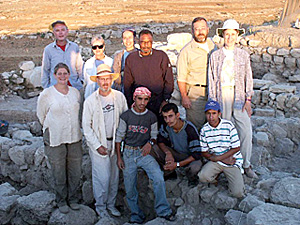 But excavators in Field L on the southern lip of the tell thought the new wind direction was great. Normally the hottest field on the tell (because it is sheltered from the westerly winds by a slight rise in the topography), the north wind funneled through two ancient rock piles and made conditions almost comfortable. Moreover, the lack of sift piles north of the field kept the air clear of dust.
But excavators in Field L on the southern lip of the tell thought the new wind direction was great. Normally the hottest field on the tell (because it is sheltered from the westerly winds by a slight rise in the topography), the north wind funneled through two ancient rock piles and made conditions almost comfortable. Moreover, the lack of sift piles north of the field kept the air clear of dust.
Along the Kings’ Highway
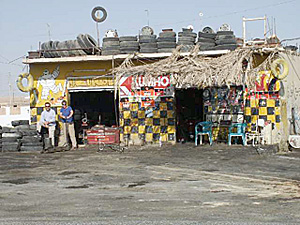 On Sunday most of our group boarded a Jett Bus with David Hopkins leading the way for a trip into the ancient world along the Kings’ Highway, a route as old as frankincense caravans and as enduring as the stories of the biblical wanderings in the wilderness. We visited such places as the Crusader castle at Kerak, the wonderfully scenic Wadi Mujib (the Grand Canyon of the Middle East) with its new dam and lake, Umm ar-Rasas with its many Byzantine churches and mosaic floors, Machaerus (the Herodian palace where, tradition has it, John the Baptist was beheaded), Madaba with its marvelous mosaics, and Mt. Nebo overlooking the Jordan Valley, Jericho, and the Dead Sea. It was a long trip, but we traveled from Neolithic times (the site above the lake in the Wadi Mujib) to the Crusader period .
On Sunday most of our group boarded a Jett Bus with David Hopkins leading the way for a trip into the ancient world along the Kings’ Highway, a route as old as frankincense caravans and as enduring as the stories of the biblical wanderings in the wilderness. We visited such places as the Crusader castle at Kerak, the wonderfully scenic Wadi Mujib (the Grand Canyon of the Middle East) with its new dam and lake, Umm ar-Rasas with its many Byzantine churches and mosaic floors, Machaerus (the Herodian palace where, tradition has it, John the Baptist was beheaded), Madaba with its marvelous mosaics, and Mt. Nebo overlooking the Jordan Valley, Jericho, and the Dead Sea. It was a long trip, but we traveled from Neolithic times (the site above the lake in the Wadi Mujib) to the Crusader period .
This week we said goodbye to most of our first-half-only participants: Myron Widmer, Billy Fitzhugh, Audrey Schaffer, and Gary Arbino (see them and everyone else in the photos section of the Jordan Updates 2004 on the MPP-`Umayri website). We will miss the individual contributions all of them made to the team endeavor. But new arrivals have already filled some of those niches and have brought new talents and dynamics, as well: Carolyn Waldron, John and Myken McDowell, and Ralph Kneller. The team is now complete for the second half.
Evenings at ATC
While weekends are free for tripping around Jordan and learning more about its cultural heritage, ancient and modern, and while most of the time during week days is spent excavating and processing finds, evenings provide a variety of options. Week nights will often find dig members working on notebooks or traveling downtown to the suq (market places) to shop for necessities as well as souvenirs to take home, resulting at times in massive excessive luggage charges on the return trip. Crashing into bed early is not out of the question either, depending on how far along in the week one makes the observation. One working hypothesis from a university study (maybe it was just a cartoon) has it that university students tend to build energy throughout the week, dragging on Monday (and maybe even crashing early then), then rising to high levels of energy by Friday in preparation for the weekend, which of course tends to drain them for the next Monday. Teachers, on the other hand, seem most energetic on Monday, enthusiasm waning toward Friday (with accompanying early crashing near the end of the week) due to exhaustion from the week’s work. From the study, it was clear that Wednesdays marked the time of intersecting mid-level energy expression, suggesting that teachers and students really only understand and communicate with each other midweek.
Tuesdays and Thursdays involve lectures/presentations which credit-earning students have to attend, but which are also open to all. Thus far during the dig we have held two major lectures (The Research Design of MPP-‘Umayri and The Archaeological Chronology of Ancient Syria/Palestine) and two “Learning Station Visits” (1—Labs involving artifacts, ceramics, grind-stone tools and textiles and 2—Recording/publication techniques using computers, photography, print media and presentations). This week brought us to what we call “Town Hall Meetings.” Utilizing specialists and PowerPoint presentations, we view artifacts/sites and discuss issues of all kinds surrounding archaeological periods tied to Tall al-‘Umayri and its environs. The Site and the dolmen were discussed on Tuesday night while the settlements during the Early, Middle and Late Bronze Ages occupied Thursday’s lecture. Next week, we are off to the Iron Ages. These are important occasions not only for seeking to understand in synthetic fashion what we are doing at ‘Umayri, but for integrating our findings with the ancient world around us.
There Was Also Archaeology
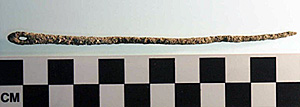 Even with the north wind and higher than normal temperatures at the tell we still made significant finds. In Field A Brenda Adams and Andrew Curtis found two more bronze needles. Normally, one is par for the course for the complete excavation season, but that one square now has discovered three, all from the same spot in a large bin. Mary Boyd,
Even with the north wind and higher than normal temperatures at the tell we still made significant finds. In Field A Brenda Adams and Andrew Curtis found two more bronze needles. Normally, one is par for the course for the complete excavation season, but that one square now has discovered three, all from the same spot in a large bin. Mary Boyd, 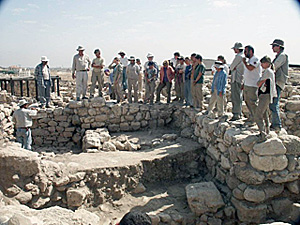 our textile specialist, quipped that they must have found the town’s tailor shop. Christine Shaw and Gary Arbino (now joined by Ralph Kneller when Gary left near the end of the week) seem to have found two Iron 1 floors on different levels (12 th century BC). An ancient split-level house? John McDowell and Cynthia Temoin uncovered a nicely laid cobble floor that solves some tricky stratigraphic problems. The two northern squares of Field A are beginning to come solidly into the Iron 1 period (12 th to 11 th centuries BC).
our textile specialist, quipped that they must have found the town’s tailor shop. Christine Shaw and Gary Arbino (now joined by Ralph Kneller when Gary left near the end of the week) seem to have found two Iron 1 floors on different levels (12 th century BC). An ancient split-level house? John McDowell and Cynthia Temoin uncovered a nicely laid cobble floor that solves some tricky stratigraphic problems. The two northern squares of Field A are beginning to come solidly into the Iron 1 period (12 th to 11 th centuries BC).
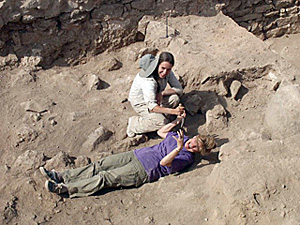 But the find of the week was made in Field B. Called a “Whale Shrine” by discoverers Ellen Bedell, Monique Acosta, Janelle Worthington, and Matt Vincent, it is a uniquely shaped stone with a domed top rising above the brick destruction surrounding it like a breaching whale. The stone is standing on end and is situated in a niche cut into a mudbrick wall in the northwest room of our large Late Bronze Age building (14 th-13 th century BC). Behind the niche is a room in which several complete pottery vessels and some unfired figurines were found last season. We have not yet reached the floor of the room and do not yet have the bottom of the stone or its niche. Unfortunately, Ellen is leaving on Monday and will not be present when we complete excavation of the room. During the usual Friday tour of Field B, therefore, the discoverers ceremonially “sacrificed” Ellen in front of the stone. Although the directors have been overheard to use the “shrine” word when discussing possible interpretations, they have studiously refrained from using the word in any “official” capacity! They seem to adhere to the conservative archaeological maxim that “the more mundane interpretation is preferable,” especially since archaeologists are all too well known for defaulting to cultic explanations for what they cannot explain otherwise.
But the find of the week was made in Field B. Called a “Whale Shrine” by discoverers Ellen Bedell, Monique Acosta, Janelle Worthington, and Matt Vincent, it is a uniquely shaped stone with a domed top rising above the brick destruction surrounding it like a breaching whale. The stone is standing on end and is situated in a niche cut into a mudbrick wall in the northwest room of our large Late Bronze Age building (14 th-13 th century BC). Behind the niche is a room in which several complete pottery vessels and some unfired figurines were found last season. We have not yet reached the floor of the room and do not yet have the bottom of the stone or its niche. Unfortunately, Ellen is leaving on Monday and will not be present when we complete excavation of the room. During the usual Friday tour of Field B, therefore, the discoverers ceremonially “sacrificed” Ellen in front of the stone. Although the directors have been overheard to use the “shrine” word when discussing possible interpretations, they have studiously refrained from using the word in any “official” capacity! They seem to adhere to the conservative archaeological maxim that “the more mundane interpretation is preferable,” especially since archaeologists are all too well known for defaulting to cultic explanations for what they cannot explain otherwise.
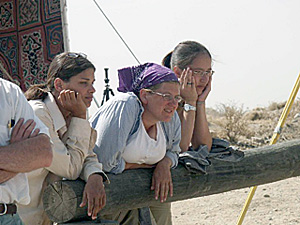 Field H spent a large portion of the week excavating small loci including surfaces and pits in order to remove the walls of a late phase of the cobble-floored sanctuary complex. A couple more small fragments of model shrines and statues were found, but so far not enough has been discovered to produce a single coherent item. We also had to break a lot of stones as the wall removal began. The sledge hammer received a workout.
Field H spent a large portion of the week excavating small loci including surfaces and pits in order to remove the walls of a late phase of the cobble-floored sanctuary complex. A couple more small fragments of model shrines and statues were found, but so far not enough has been discovered to produce a single coherent item. We also had to break a lot of stones as the wall removal began. The sledge hammer received a workout.
Wall phasing was also the goal in Field L where we discovered several answers to questions centering around the relationship of Hellenistic walls (2 nd century BC) to late Iron 2 walls (6 th century BC). Part of the solution was in the discovery of pits. Pits are the bane of every archaeologist. The ancient inhabitants dug them for many uses, but when they did so, they destroyed earlier remains. Some pits are difficult for us to recognize and we only realize their existence after we have dug through them. Such was our situation in Field L. No wonder we kept getting pottery that dated from periods later than that in which we should have been digging!
North winds may blow and we may get dusty faces, but what we find brings to life the way ancient people lived out their lives. They had to live through north winds, too.
[Check out the photos of dig participants on this same website.]